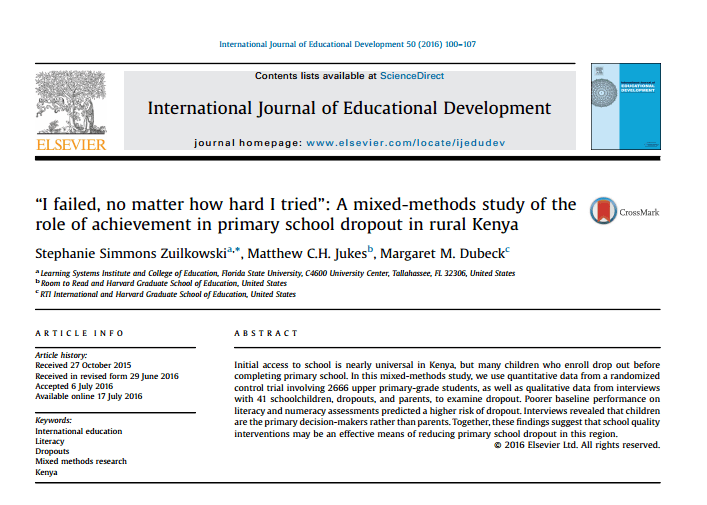In Kenya, virtually every child enrolls in primary school, but many don’t complete it. Stephanie Simmons Zuilkowski, Matthew Jukes, and Peggy Dubeck use mixed methods to explore why.
Three findings stood out to me:
- In interviews with both youth and with parents, the youth (age 14-15, mostly, but some older) were “universally” characterized as the main education decision makers. In many cases, parents encouraged them to stay in school but the youth opted to drop out.
- Lower performing youth were more likely to drop out of school. This isn’t surprising but it’s useful to see it quantified. It comes out in both the quantitative and the qualitative work here.
- Free primary school isn’t free (and I’m not even talking about pure opportunity cost; I’m talking about simple out-of-pocket costs).
Okay, to the study! They point out why cross-sectional studies may miss the point in understanding dropout rates:
A cross-sectional study may identify proximal factors affecting dropout risk—perhaps pregnancy or the need to work for pay (Ball 2012)—but not the earlier factors that put the child on the trajectory toward dropout. In interviews with parents and teachers, proximal reasons for dropout may become the post-hoc rationale for a child’s dropout obscuring the underlying trigger factors.
Finding 1: Who decides on dropouts? Admittedly, it’s a small sample for this part: They spoke with 21 youth and 20 parents. In most cases, the interviews were conducted separately. Of the youth, half had dropped out. Here is the key finding: “In our interviews with the dropouts in this sample, the youth were described universally as the principal educational decision-makers, both by the parents and by the youth themselves.” Notably, both youth and parents talked about the importance of education. “The stories of all 11 children who dropped out began with some variation of: ‘I wasn’t doing well in school.’” Many of the quotes highlight relative performance and the inability to get extra help. To me, this points back to the importance of structuring education systems that help teachers to teach to the right level (see here and here for more on that). Many of these children simply weren’t getting instruction at their current level.
Finding 2: “A student with a literacy composite score one standard deviation above average would have fitted odds of dropout that are 40% lower than those of the average scorer. A student with a numeracy score one standard deviation above average would have fitted odds of dropout that are 17% lower than those of the average scorer.” N=2,500+
Finding 3: “Despite the official abolition of school fees, all 13 schools the sampled youth attended had charged fees for extra teachers, books, or materials. Nine of the 21 interviewees—five students and four dropouts—said they had been sent home to get money for fees or materials. Children who could not gather the required amounts were not generally allowed back in class.”
I recommend the paper.
